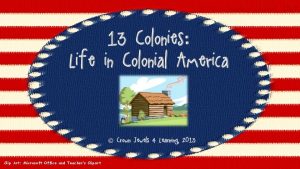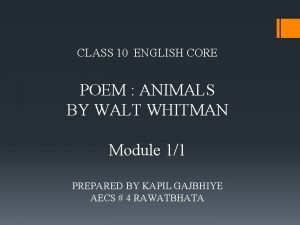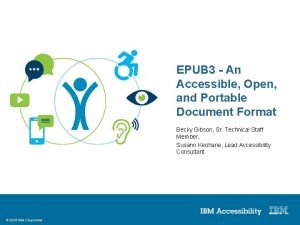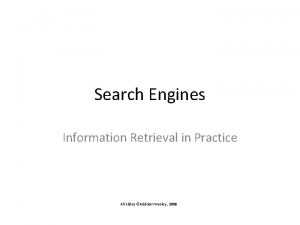Disclaimer The slides and the information contained in






























- Slides: 30

Disclaimer The slides and the information contained in these slides is the property of the WBFI Research Foundation. All rights to use or disseminate the information contained in these slides remains at the discretion of the WBFI Research Foundation. Data shown are preliminary and do not represent the final results.

PROJECT WILDBIRD Food and Feeder Preferences of Wild Birds in the United States and Canada Dr. David J. Horn Department of Biology, Millikin University A Research Project Supported by The Wild Bird Feeding Industry Research Foundation

Background > Over 55 million Americans and Canadians over the age of 16 watch and feed wild birds around their homes and spend more than 3 billion dollars on birdseed alone. > While several studies have examined seed and feeder preferences, the most important questions have not yet been adequately answered.

Our opportunity > For the Wild Bird Feeding Industry to conduct the most comprehensive scientific study ever performed on seed and feeder preferences of wild birds in the United States and Canada. PROJECT WILDBIRD

Objectives > What are the seed preferences of birds that use feeders in the U. S. and Canada? > Are seed preferences of birds equivalent in different regions of the U. S. and Canada? > Are seed preferences of birds equivalent at different times of the year? > What are the feeder preferences of birds in the U. S. and Canada? > Is there an interaction between seed preferences and feeder preferences?

Project scope > Upon completion of this study, we will know the seed and feeder preferences of common backyard birds in the United States and Canada. > The study will be continent-wide in scope and provide advice to individuals specific to most regions of the continent during different seasons of the year.

Method of research > The study began fall 2005 and will continue through fall 2008. > The study is being conducted in the U. S. and Canada and four geographic regions will be compared.

Method of research (cont. ) Website – www. projectwildbird. org

Method of research (cont. ) > Observational Approach § The approach involves distributing a feeder survey to participants four times a year for up to three years. § The survey collects data about the type of feeders present in a yard, types of seed offered at each feeder, and the number and species of birds visiting each feeder over two hours of observation. § Participants also complete a questionnaire on bird feeding habits, and characteristics of the yard and neighborhood.

Method of research (cont. ) > Experimental Approach § Participants in the experimental approach are assigned specific feeder and seed combinations. § Participants record the number of each species of bird present at each feeder throughout the year. § Feed, feeders, poles, baffles and shipping are provided by the generous WBFI members here today.

Method of research (cont. ) “The birds are going through the black oil like candy. I fill the feeder each morning because they empty it each day. If I would do it, I could probably fill it twice a day. ” - R. Mayhorn, Virginia

Results – Observational approach > At the end of summer 2007, 12, 454 bird visits of 76 species have been recorded at feeders. > The 10 most abundant species from most to least number of observations were: American Goldfinch, House Sparrow, House Finch, Black-capped Chickadee, Common Grackle, Mourning Dove, Northern Cardinal, Dark-eyed Junco, Tufted Titmouse, and Whitebreasted Nuthatch. > Observational participants that have been collecting bird data reside from coast to coast coming from the 21 states and 3 Canadian provinces.

Results – Observational approach > 269 observational participants completed the questionnaire.

Why do you feed birds? (Respondents checked all that applied) > Enjoy the sound of birds in the yard 82% > Hobby/Fun 81% > Brings nature and beauty to the area 81% > Want to help the birds 75% > Learning bird behavior/Identifying species 65% > Therapy/Relaxation 58% > Maintain a list of bird species seen in yard 38% > As part of the landscaping 35% > As an educational experience for children 28% > Other 12%

Results – Experimental approach > At the end of summer 2007, 411, 617 bird visits of 94 species have been recorded during 5, 587 45 -minute observations at feeders. > The 10 most abundant species from most to least number of observations were: House Sparrow, House Finch, American Goldfinch, Brown-headed Cowbird, Northern Cardinal, Black-capped Chickadee, Mourning Dove, Pine Siskin, Common Grackle, and Purple Finch. > 129 experimental citizen scientists have been collecting bird data and reside from 33 states and 2 Canadian provinces.

Results – Experimental approach > 129 experimental citizen scientists have been collecting bird data, and reside from 33 states and 2 Canadian provinces.

American Goldfinch abundance at 10 food types

Carolina Chickadee abundance at 3 feeder types

Pine Siskin abundance at 4 regions

Tufted Titmouse abundance during 4 seasons

Outcomes > Observational Approach 269 individuals have completed the questionnaire on bird feeding habits. > Experimental Approach 129 citizen scientists have recorded 411, 617 bird visits of 94 species during 22, 347 45 -minute observations.

Outcomes > Historic scientific study on the seeds and feeders to provide birds with by geographic region and time of the year. > Study will be the first of many landmark scientific studies to examine wild bird feeding.

PROJECT WILDBIRD Contributors BENEFACTOR > Wild Bird Centers of America, Inc.

PROJECT WILDBIRD Contributors PATRONS > D&D Commodities, Ltd. > Percevia. com

PROJECT WILDBIRD Contributors PLATINUM CONTRIBUTORS > Anderson Seed > Central Avian & Small Animal (Kaytee) > Essex Topcrop Sales, Ltd. > Kaytee Avian Foundation > Oilseeds International Ltd. > Wagner’s LLC > Wild Bird Feeding Industry (WBFI)

PROJECT WILDBIRD Contributors GOLD CONTRIBUTORS > Lebanon Seaboard > National Sunflower Association > Red River Commodities

PROJECT WILDBIRD Contributors SILVER CONTRIBUTORS > Armstrong Milling Keystone Grain > Commodity Marketing North Bag and Box > Dick and Carole Hebert Pumpernickel Press > Droll Yankee Sunbird, Inc. > Duncraft > Erva Tool & Die Co. , Inc > ETO Sterilization > Hawkeye Commodities > Heath Outdoor Products > Imports Sterilization Inc.

PROJECT WILDBIRD Contributors BRONZE CONTRIBUTORS > All Star Trading > Central Distributing > Cereal By-Products > Crest Flavor Company > Empire Seed & Grain > High Country Mercantile > Masterfoods > North Pacific Ag Products > Novabird > Perry Brothers Seed, Inc. > Wild Bird Seeds & Such > Wild Birds Unlimited

PROJECT WILDBIRD Contributors PIONEER CONTRIBUTORS > Artline, Inc. Heritage Farms > Backyard Nature Products Jean Cowden > Birdola Products Knight Seed > Birdgeway Trading Corp. MGT Co. , Sue Hays > Cabin Fever Woodworking North Central Companies > Cello Polly North Star Packaging > Central/Valley Bag Prince Corporation > David Horn Reggie Vanden Bosch > Denise Townsend Tami Hebert > Des Moines Truck Brokers Ltd. The Industrial Fumigant Co. > E. Cohen & Co. CPA’s Vari-craft > Elizabeth Mohan Woodstream Corporation > George Petrides, Sr.

Questions Dr. David J. Horn Department of Biology Millikin University 1184 W. Main St. Decatur, IL 62522 217 -424 -6392 dhorn@millikin. edu FAX: 1 -217 -424 -3917
 The newspaper report contained important information
The newspaper report contained important information A small child slides down the four frictionless slides
A small child slides down the four frictionless slides A crane lowers a girder into place at constant speed
A crane lowers a girder into place at constant speed Which colonial region contained rocky soil and cold climate
Which colonial region contained rocky soil and cold climate 10 figure of speech
10 figure of speech The potion contained fruit biscuits and glue
The potion contained fruit biscuits and glue What problems did this election underscore adams
What problems did this election underscore adams A whalebone that originally contained 200 grams
A whalebone that originally contained 200 grams A sample of gas in a rigid cylinder
A sample of gas in a rigid cylinder Why must an arcing device be contained
Why must an arcing device be contained Earths early atmosphere contained
Earths early atmosphere contained Contained rock asphalt mat
Contained rock asphalt mat Readium features
Readium features Rzeczp
Rzeczp Self contained underwater breathing apparatus
Self contained underwater breathing apparatus Self contained underwater breathing apparatus
Self contained underwater breathing apparatus Enable contained databases
Enable contained databases Search engines information retrieval in practice
Search engines information retrieval in practice The views and opinions disclaimer
The views and opinions disclaimer Disclaimer the views and opinions expressed
Disclaimer the views and opinions expressed The views and opinions expressed disclaimer abs-cbn
The views and opinions expressed disclaimer abs-cbn Hát kết hợp bộ gõ cơ thể
Hát kết hợp bộ gõ cơ thể Frameset trong html5
Frameset trong html5 Bổ thể
Bổ thể Tỉ lệ cơ thể trẻ em
Tỉ lệ cơ thể trẻ em Chó sói
Chó sói Thang điểm glasgow
Thang điểm glasgow Chúa sống lại
Chúa sống lại Các môn thể thao bắt đầu bằng tiếng đua
Các môn thể thao bắt đầu bằng tiếng đua Thế nào là hệ số cao nhất
Thế nào là hệ số cao nhất Các châu lục và đại dương trên thế giới
Các châu lục và đại dương trên thế giới






















































